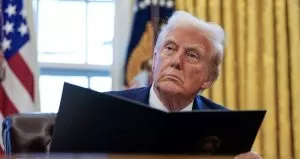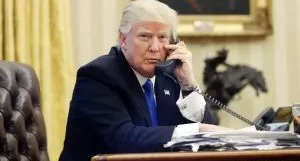European Central Bank Slashes Interest Rates as Trump’s Tariffs Threaten Eurozone Economy

The European Central Bank (ECB) cut its key deposit facility rate by 25 basis points to 2.25% today, marking its seventh consecutive reduction since June 2024. The widely expected move reflects growing concerns over the eurozone’s economic outlook, as U.S. President Donald Trump’s aggressive tariff policies cast a long shadow over the region’s export-driven markets. With inflation stabilizing and growth faltering, the ECB is shifting gears to bolster the economy, but analysts warn that monetary easing alone may not shield the eurozone from the looming threat of a trade war.
Trump’s Tariffs: A Gathering Storm
On April 2, 2025, President Trump announced a sweeping set of tariffs, including a 10% baseline duty on all global imports, 20% on EU goods, and up to 50% on Chinese products. Additionally, a 25% levy on European auto exports to the U.S. has raised alarms in Germany, France, and Italy, where the automotive sector is a cornerstone of economic activity. While these measures are suspended for 90 days to allow for negotiations, their potential implementation threatens to disrupt the eurozone’s fragile recovery.
The EU exported €382 billion in goods to the U.S. in 2024, with vehicles accounting for €46.3 billion. The Kiel Institute for the World Economy estimates that a blanket 25% tariff on EU exports could reduce eurozone GDP by 0.4% in the first year, with Germany bearing the brunt due to its reliance on U.S. markets. Moody’s Analytics has warned that persistent tariffs could push the region into recession by mid-2025, compounding existing challenges like high energy costs and geopolitical tensions.
Trump’s tariffs, enacted under the International Emergency Economic Powers Act, aim to address the U.S. trade deficit, which reached $971 billion in 2024. However, they risk sparking retaliatory measures from the EU, which is considering counter-tariffs on U.S. goods like agricultural products and tech exports. Such escalation could further disrupt global supply chains, as evidenced by the 5% drop in the S&P 500 on April 3, 2025, and a corresponding decline in European indices like the Stoxx 600.
ECB’s Response: Easing to Avert a Downturn
The ECB’s latest rate cut comes against a backdrop of persistent economic weakness. The eurozone economy stagnated in the final quarter of 2024, with Germany and France reporting GDP contractions of 0.3% and 0.2%, respectively. Business confidence, as measured by the Purchasing Managers’ Index (PMI), fell to 48.6 in March 2025, signaling ongoing contraction in manufacturing and services.
Inflation, at 2.4% in February 2025, remains close to the ECB’s 2% target, giving policymakers room to prioritize growth over price stability. ECB President Christine Lagarde underscored a “data-dependent” approach in her April 17 press conference, noting that while tariffs could drive short-term inflation through higher import costs, their primary impact would likely be a drag on growth. “We are prepared to act as needed to support the eurozone economy,” Lagarde said, while avoiding firm commitments on future cuts.
Analysts at Goldman Sachs expect the ECB to “look through” tariff-induced inflation spikes and continue easing, projecting the deposit rate to fall to 2% by June 2025. In a worst-case scenario involving a full-scale trade war, rates could drop to 1.5% by year-end. Deutsche Bank economists echoed this view, citing the need to offset declining exports and weakening consumer demand.
Internal Divisions and Policy Outlook
Within the ECB’s Governing Council, opinions on the pace of easing vary. Dovish members, such as France’s François Villeroy de Galhau, argue for rapid cuts to reach a “neutral” rate—estimated between 1.75% and 2.25%—to stimulate investment and consumption. “We cannot afford to lag behind the economy’s needs,” Villeroy said in a recent interview. Conversely, hawkish policymakers like Austria’s Robert Holzmann caution against overstimulating, warning that premature easing could fuel inflation if supply chains stabilize or energy prices rebound.
The ECB’s March 2025 meeting hinted at a possible pause in rate cuts, but Trump’s tariff announcement has tilted sentiment toward further action. Market pricing now reflects expectations of two to three additional 25-basis-point cuts by December 2025, with the probability of a 50-basis-point cut in June rising to 40%, according to Bloomberg data. The euro weakened 0.3% against the dollar following the ECB’s decision, trading at $1.05, while European bond yields dipped, with Germany’s 10-year Bund yield falling to 2.1%.
Broader Economic Challenges
Beyond tariffs, the eurozone faces structural headwinds that limit the ECB’s ability to maneuver. Rising defense spending, driven by NATO commitments and geopolitical risks, is straining public budgets in countries like Germany and Italy. The EU’s green transition, while critical, requires massive investments that could crowd out private sector borrowing. Meanwhile, China’s economic slowdown—projected growth of 4.2% in 2025—reduces demand for European exports, adding pressure on manufacturers.
The ECB’s rate cuts aim to lower borrowing costs for businesses and households, but their impact may be muted. Corporate loan demand fell 2% year-on-year in Q1 2025, reflecting caution amid trade uncertainties. Household spending, while supported by real wage growth, remains subdued due to high savings rates and fears of job losses in export sectors.
Global Implications and the Risk of a Trade War
Trump’s tariffs are part of a broader “America First” agenda that includes tax cuts and deregulation, which could boost U.S. growth to 2.8% in 2025, according to the International Monetary Fund. However, the global fallout could be severe. The World Trade Organization warns that a U.S.-EU trade war could shave 1.5% off global GDP by 2027, with emerging markets like Mexico and Canada also at risk due to proposed 25% tariffs.
For the eurozone, the stakes are high. A protracted trade conflict could erode the region’s competitiveness, particularly if the EU’s retaliatory measures fail to deter U.S. policy. The ECB’s ability to cushion the blow will depend on its agility in adjusting rates and its coordination with fiscal authorities. EU leaders are set to discuss a unified response at a summit in May 2025, with proposals ranging from targeted tariffs to increased subsidies for affected industries.
Conclusion
The ECB’s decision to cut rates to 2.25% underscores its commitment to supporting the eurozone economy amid mounting external pressures. President Trump’s tariffs, while not yet in effect, have already rattled markets and forced policymakers to rethink their strategy. With growth forecasts downgraded to 0.9% for 2025 and inflation risks lingering, the ECB faces a delicate balancing act. Further rate cuts are likely, but their effectiveness will hinge on the trajectory of U.S.-EU trade negotiations and the region’s ability to navigate a turbulent global landscape. As Lagarde put it, “Uncertainty is the only certainty we have.” For now, the eurozone is bracing for impact







